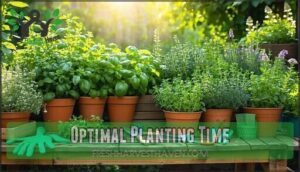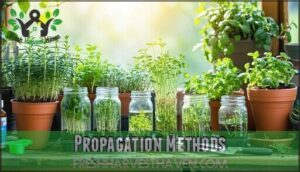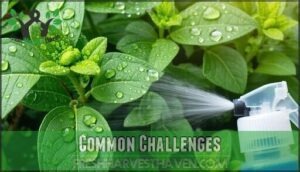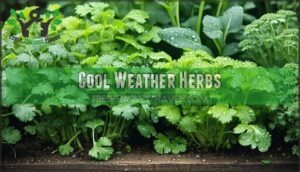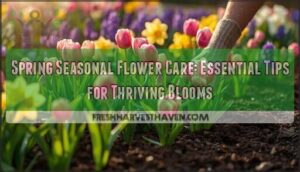This site is supported by our readers. We may earn a commission, at no cost to you, if you purchase through links.
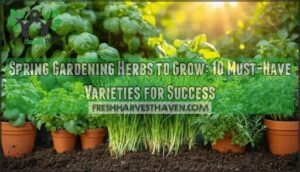 Spring gardening herbs to grow include both cool and warm-season varieties that’ll keep your kitchen stocked year-round.
Spring gardening herbs to grow include both cool and warm-season varieties that’ll keep your kitchen stocked year-round.
Start with frost-tolerant champions like cilantro, chives, and parsley in early spring when soil’s still cool. These hardy herbs don’t mind a light frost and actually prefer cooler weather.
As temperatures warm up, plant heat-lovers like basil, dill, and oregano. You can stagger plantings every few weeks for continuous harvests.
Most herbs need well-draining soil and at least six hours of sunlight daily. Container growing works perfectly if you’re short on garden space.
The secret lies in knowing which herbs thrive in which season and timing your plantings accordingly, to achieve a year-round supply of fresh herbs.
Table Of Contents
- Key Takeaways
- Popular Spring Herbs
- Herb Planting Basics
- Spring Herb Care
- Warm Weather Herbs
- Cool Weather Herbs
- Frequently Asked Questions (FAQs)
- What herbs can you plant in spring?
- When should I start my herb garden?
- What herbs are easy to grow for beginners?
- Is April too early to plant herbs?
- What herbs grow best in spring?
- When to start planting herbs for spring?
- What are the best herbs to grow for beginners?
- What herbs are in season in April?
- How can I prevent herbs from bolting prematurely?
- Can I grow herbs in small apartments?
- Conclusion
Key Takeaways
- Start cool-season herbs like cilantro, chives, and parsley in early spring when soil’s still cool – they’ll tolerate light frost and prefer cooler weather over summer heat.
- Plant heat-loving herbs like basil, dill, and oregano after your last frost date when soil temperatures consistently reach 60°F or higher.
- Ensure your herbs get well-draining soil and at least six hours of direct sunlight daily – waterlogged roots will kill most herb varieties.
- Harvest regularly by pinching flower buds and cutting outer stems first to keep plants producing fresh leaves throughout the growing season.
Popular Spring Herbs
You’ll find that certain herbs perform exceptionally well when planted in spring, offering both culinary versatility and reliable growth in your garden.
These popular varieties include cilantro, dill, chives, and chamomile, each bringing unique flavors and practical benefits that make them essential additions to any beginner or experienced herb gardener’s collection, with chamomile being a notable example.
Cilantro and Dill
Jump into cilantro and dill cultivation early in your growing seasons.
Transform your spring garden into a flavorful haven with these essential herb-growing secrets that deliver fresh harvests all season long.
Cilantro bolts quickly in heat, so plant it in spring’s cool embrace with moist soil and partial sun. Dill thrives in full sun with consistent moisture.
Both spring gardening herbs offer distinct flavor profiles – cilantro’s citrusy punch and dill’s feathery freshness.
For best results, consider companion planting herbs to maximize space and enhance garden health.
Practice seed saving from mature plants for continuous harvests.
Chives and Chamomile
While dill and cilantro excel in cooking, chives and chamomile bring different strengths to your spring gardening herbs collection.
You’ll love these hardy perennials for their reliability and versatility.
Chive Varieties offer mild onion flavor perfect for Culinary Uses in eggs, soups, and salads.
Chamomile Benefits include soothing tea and natural pest deterrent properties through Companion Planting.
Consider these Harvesting Tips:
- Snip chive leaves regularly to encourage growth
- Pick chamomile flowers when fully open for maximum potency
- Both herbs reward frequent harvesting with continued production
Herb Planting Basics
You’ll need to understand three key elements before planting your spring herbs: timing, soil conditions, and how to start your plants.
Most herbs require well-drained soil, at least six hours of direct sunlight, and can be grown from either seeds or nursery transplants depending on whether they’re annual or perennial varieties.
Optimal Planting Time
Perfect timing makes your spring herb garden thrive.
Plant when frost fears fade and soil warms—your herbs will reward perfect timing with abundant harvests.
Plant after your region’s frost dates when soil reaches proper germination temperature for seed starting success.
Cool-season herbs like cilantro tolerate earlier planting, while basil needs warmer conditions.
Check soil readiness by ensuring temperatures stay consistently above 60°F.
Regional variations affect timing, so monitor local forecasts for ideal spring herbs planting results.
Consider your hardiness zone guidelines to fine-tune planting schedules.
Soil and Sunlight Requirements
Once you’ve nailed down your planting timing, your herbs need the right foundation to thrive. Spring gardening success starts with understanding your soil and sunlight requirements.
Most herbs demand at least six hours of direct sunlight intensity daily. Proper drainage needs rank equally important—waterlogged roots spell disaster for your herb garden. Many herbs require at least six hours of sunlight each day.
Here’s what your herbs need for ideal growth:
- Soil pH between 6.0-7.0 for most varieties
- Nutrient levels that aren’t overly rich or heavy
- Soil amendments like compost for better structure
- Drainage needs met through raised beds or added sand
Propagation Methods
Once you’ve got your soil and sunlight figured out, Seed Starting offers the most budget-friendly approach for herb propagation.
Cuttings Propagation works best for woody herbs like rosemary and sage—just snip 4-6 inch stems and root them in water. Division Methods suit clumping herbs such as chives and mint perfectly.
Herb propagation using stem cuttings is a common and effective method.
| Method | Best For | Timeline |
|---|---|---|
| Seed Starting | Annual herbs, cilantro, dill | 2-3 weeks |
| Cuttings Propagation | Woody perennials, basil, mint | 1-2 weeks |
| Division Methods | Established clumps, chives | Immediate |
| Layering Herbs | Ground-huggers, thyme | 4-8 weeks |
Rooting Hormones can boost success rates for stubborn herb cuttings.
Spring Herb Care
Once you’ve planted your spring herbs, proper care guarantees they’ll thrive throughout the growing season and provide fresh flavors for your kitchen.
You’ll need to master three key areas: watering and fertilization techniques, pruning and pest management, and recognizing common challenges that can affect herb growth.
Watering and Fertilization
When spring gardening kicks into high gear, you’ll discover that proper watering and fertilizing make the difference between thriving herbs and struggling plants.
Understanding watering frequency prevents both drought stress and root rot, while choosing appropriate fertilizer types guarantees robust growth without compromising flavor.
Monitor soil moisture by sticking your finger into the earth—it should feel like a wrung-out sponge. Watch for overwatering signs like yellowing leaves or musty odors. Many factors affect herb watering frequency.
- Water herbs early morning to reduce disease risk
- Use diluted liquid fertilizer every 2-3 weeks during growing season
- Check for nutrient deficiencies through leaf discoloration patterns
- Allow soil surface to dry slightly between waterings
- Apply organic compost as slow-release nutrition source
Pruning and Pest Control
Beyond proper watering, pruning techniques keep your spring herbs healthy and productive.
Snip flower buds before they open to maintain tender leaves and prevent plants from going to seed.
For pest identification, check regularly for aphids on new growth and holes from caterpillars.
Organic solutions like neem oil spray work effectively against most herb pests without harming beneficial insects.
Practice tool sterilization by wiping pruners with rubbing alcohol between plants to prevent disease prevention issues.
Consider using specialized pruning tools for precise cuts.
Regular herb pruning also improves air circulation, naturally boosting pest resistance while encouraging bushier growth in your spring gardening efforts.
Common Challenges
Even seasoned gardeners encounter pest problems and disease control issues with spring herbs.
Poor drainage creates soil issues leading to root rot, while inconsistent herb watering triggers yellowing leaves. Herb diseases thrive in overcrowded conditions with inadequate herb sunlight exposure.
Combat herb pests through regular inspection and natural remedies. Make certain proper herb soil preparation prevents most challenges.
One common issue is aphid infestations, which can be managed with soapy water or neem oil.
Consider overwintering herbs indoors and practice bolting prevention by planting cool-season varieties early.
Warm Weather Herbs
You’ll want to plant your warm-weather herbs after the last frost passes and soil temperatures reach 60°F consistently.
These heat-loving varieties like basil, dill, and lemon balm thrive in summer’s warmth and provide fresh flavors for your kitchen throughout the growing season.
Basil and Its Uses
Growing basil transforms your spring gardening into a flavorful adventure. This aromatic powerhouse offers incredible versatility, from classic sweet basil perfect for pesto recipes to spicy Thai varieties that elevate Asian dishes.
Basil varieties provide exceptional culinary applications while delivering impressive health benefits including antioxidants and digestive support.
- Growing tips: Start seeds indoors six weeks before last frost for stronger transplants
- Harvest timing: Pinch flower buds regularly to maintain leaf production and flavor intensity
- Companion planting: Pair with tomatoes to enhance growth and repel garden pests naturally
Dill and Cilantro
Planting dill varieties and cilantro transforms your spring gardening experience into a flavorful adventure.
Both herbs thrive with spring planting but handle heat differently—cilantro bolting occurs quickly in warm weather, while dill tolerates higher temperatures.
Their culinary pairings include pickles, salads, and ethnic dishes.
Consider seed saving from mature plants, and try growing indoors for year-round harvests.
Lovage and Lemon Balm
Two powerhouse herbs deserve spots in your spring garden. Lemon balm delivers stress-busting balm benefits in teas, while lovage brings bold celery notes to soups.
Both easy spring herbs thrive in partial shade with regular watering. Lovage growing requires deeper soil for its taproot.
Culinary pairings shine when you combine lemon balm’s citrusy punch with lovage’s savory depth. Fresh herbs enhance summer salads and drinks.
- **Harvest morning leaves for maximum essential oil content and incredible flavor intensity.
Cool Weather Herbs
You’ll find that cool weather herbs like cilantro, parsley, and chervil actually prefer spring’s mild temperatures and won’t bolt to seed as quickly as they do in summer heat.
These herbs thrive in cooler conditions, giving you a longer harvest window and better flavor when you plant them early in the growing season, which allows for a more successful harvest with better flavor.
Cilantro Preferences
Cilantro’s polarizing taste perception makes it a love-it-or-hate-it herb among spring gardening enthusiasts.
You’ll maximize success with cilantro growing tips like choosing partial shade and maintaining consistently moist soil.
This cool-season herb variety bolts quickly in heat, so successive plantings guarantee fresh leaves for cilantro culinary pairings.
Cilantro substitutes like parsley work when it’s unavailable, though the unique herb flavors differ substantially.
Parsley Requirements
While cilantro prefers cooler temperatures, parsley thrives in spring gardening conditions with consistent soil moisture. This hardy herb adapts to various light exposure levels and resists common pests better than most herbs.
Parsley varieties need specific care:
- Flat-leaf Italian parsley offers bold flavor for cooking
- Curly parsley provides attractive garnish and decoration
- Soil moisture should stay consistently damp, never waterlogged
- Harvesting tips: Cut outer stems first, leaving center growth intact
Chervil Growing Conditions
While parsley thrives in various conditions, chervil demands more specific care for spring gardening success.
This delicate herb prefers cool temperatures between 50-70°F and partial shade locations.
Chervil soil needs rich, well-draining composition with consistent moisture—never let it completely dry out.
Light needs differ from sun-loving herbs since chervil actually benefits from morning sun with afternoon shade protection.
For watering tips, maintain even moisture without waterlogging the roots.
Direct sowing works best since chervil dislikes transplanting.
Companion plants like lettuce and spinach create ideal microclimates together.
Harvesting chervil regularly in early morning preserves its subtle anise flavor.
Growing this spring herb requires patience, but proper herb care rewards you with exceptional culinary results for your spring planting efforts.
Factor Ideal Condition Tips Common Issues
Frequently Asked Questions (FAQs)
What herbs can you plant in spring?
Spring awakens your garden’s potential like a green symphony.
You can plant basil, parsley, cilantro, chives, dill, thyme, and oregano.
These herbs thrive in spring’s mild temperatures and longer daylight hours.
When should I start my herb garden?
You’ll want to start your herb garden after the last frost date in your area.
Most regions can begin planting in late March through May, depending on your climate zone and local weather patterns.
What herbs are easy to grow for beginners?
Basil, chives, and mint top the beginner-friendly list.
They’re forgiving, grow quickly, and don’t need fussy care.
You’ll have fresh herbs for cooking while building your gardening confidence with these reliable starter plants.
Is April too early to plant herbs?
Don’t jump the gun—April’s timing depends on your location and frost dates.
You’ll want to wait until soil warms and frost danger passes.
Cool-season herbs like chives and parsley can handle cooler weather better.
What herbs grow best in spring?
Cool-season herbs like cilantro, chives, and parsley thrive in spring’s mild temperatures.
You’ll also succeed with thyme, oregano, and sage since they handle temperature fluctuations well and establish strong roots before summer heat arrives.
When to start planting herbs for spring?
Start planting herbs 2-4 weeks before your last frost date.
You can begin cool-season herbs like parsley and chives earlier, while warm-season varieties like basil should wait until after frost danger passes.
What are the best herbs to grow for beginners?
Like building blocks in a gardening foundation, you’ll want foolproof herbs that forgive mistakes.
Start with basil, mint, chives, and parsley—they’re resilient, grow quickly, and don’t demand perfection from novice gardeners, making them resilient choices.
What herbs are in season in April?
April’s perfect for planting cool-season herbs like cilantro, parsley, chives, and dill.
You can also start basil indoors if you’re enthusiastic.
These herbs love the mild spring weather and won’t bolt in cooler temperatures.
How can I prevent herbs from bolting prematurely?
Nearly 70% of herb gardeners struggle with premature bolting.
You’ll prevent this by providing consistent moisture, choosing bolt-resistant varieties, planting in cooler weather, and harvesting regularly to keep plants focused on leaf production.
Can I grow herbs in small apartments?
You can absolutely grow herbs in small apartments.
Choose compact varieties like thyme, chives, and basil for sunny windowsills.
Use containers with drainage, and mint thrives in partial shade if sunlight’s limited.
Conclusion
Growing your own herb garden is like planting seeds of culinary freedom in your backyard.
You’ll discover that timing is everything when selecting spring gardening herbs to grow. Start cool-season varieties like cilantro and parsley when frost still threatens, then shift to heat-loving basil and oregano as temperatures rise.
With proper soil drainage, adequate sunlight, and consistent care, you’ll harvest fresh flavors throughout the growing season.
Your kitchen will thank you for this fragrant investment in homegrown goodness.

